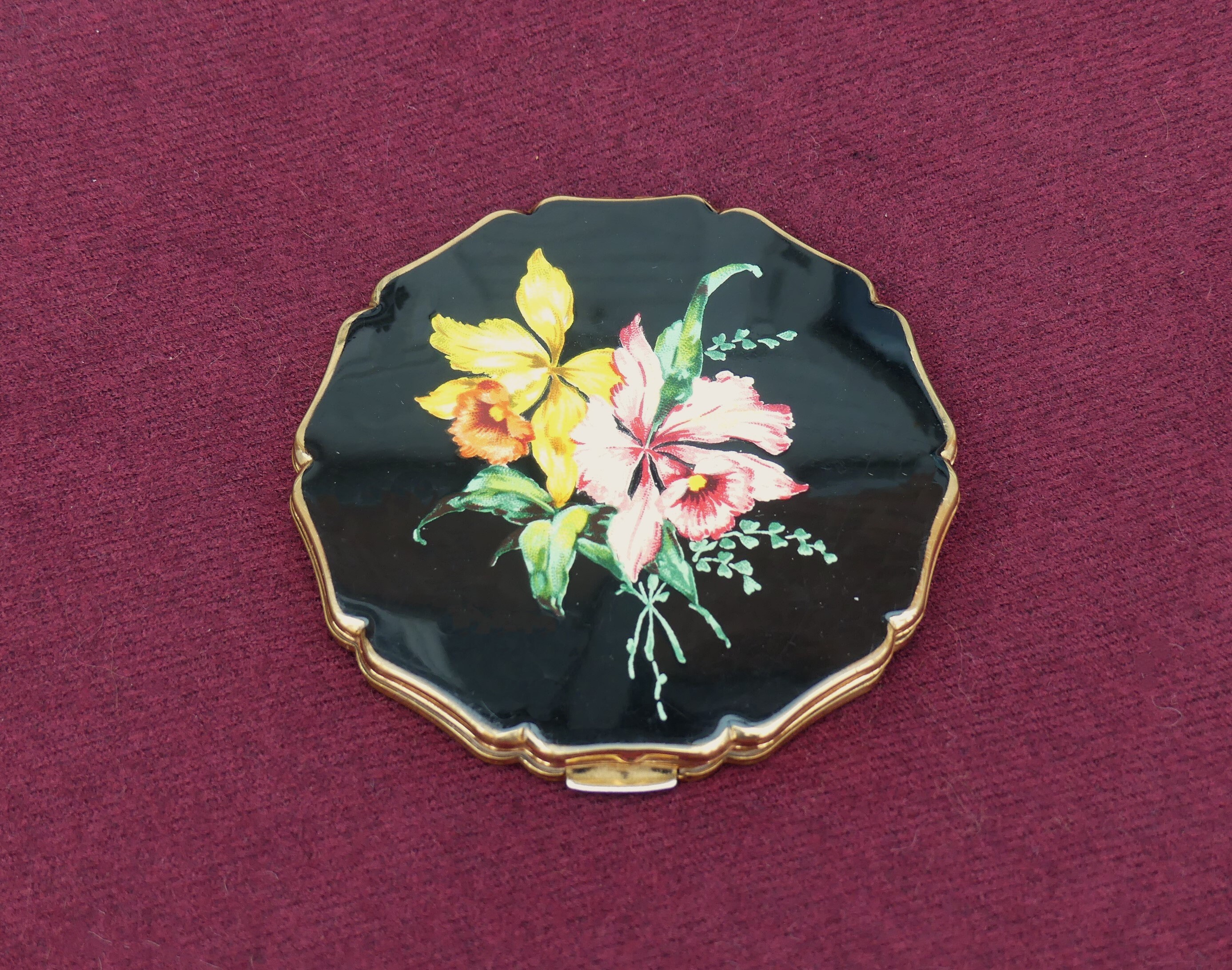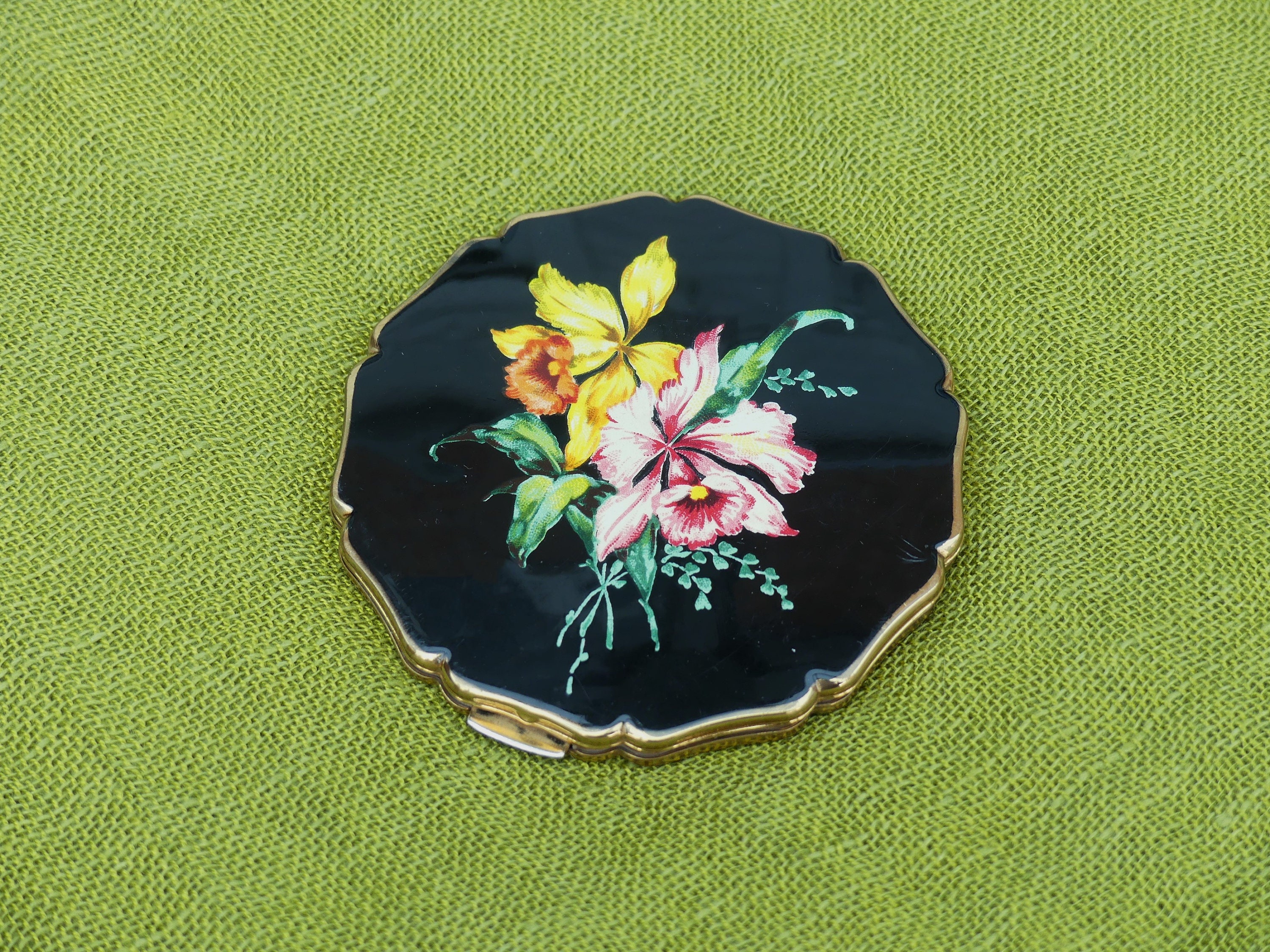Highlights










Description
Here is a gorgeous vintage powder compact, built to take loose powder only, with a hinged inner lid to keep the powder from spilling everywhere, manufactured by the famous Stratton company back in the early 1950s. A black enamel lid with a floral design of yellow and pink daffodil-like Orchids, I think - they are rather fanciful !!
This is a really typical vintage 1950s style design - this is the 'Queen' shape, with the wavy edged ten-sided circular design, which was created in the late 1950s. This particular compact has the all-over star pattern on the reverse with no signature in the centre. Instead the signature is on the inner lid inside. Apparently this dates this compact to somewhere from around 1958 to 1965, and makes it reasonably rare and therefore of particular interest to serious collectors of the Stratton brand.
The lid has the auto-open mechanism to save your polished nails - this means that you open the compact and then push the mirror back a little further and the inner lid clicks open. A lovely idea and extremely popular developemnt in powder compact design.
CONDITION:-
This compact measures 7.3 cms in diameter (2 7/8") and is in excellent condition considering it's about seventy years old - it still stays shut and opens easily, and there is no sign of the dreaded green verdigris. This has been used in the past and therefore there may be vestiges of the original powder, but it has been thoroughly cleaned out, and the mirror is in good condition with no spotting, misting or cracks of any kind. y eigth photo. On the whole, this is a lovely collector's item, even though there is no sifter or puff with this.
STRATTON
For stylish ladies of a certain age, British company Stratton needs no introduction. In the powder heydays of the 1950s and 60s, Stratton was the most recognised and prolific of the worldu2019s powder compact manufacturers.
Stratton started out in 1860 as a knitting needle manufacturer, and marketed their first powder compacts in 1923. These early compacts were imported, part-finished from the USA, and given the less than glamorous name u201cStratnoid` ? the same brand as the companyu2019s knitting needles!
By the early 1930s, the compacts became u201cStratton`s, borrowing the name from the hero in a popular novel. Iu2019d love to discover which novelu2026 I imagine a Mr. Darcy type in a high period romance! The rebrand was a success and by the mid 30s, Stratton produced over half of all compacts used in the British cosmetics industry.
However, in 1940, disaster struck. Germanyu2019s WWII blitz of Britain claimed four of the five Stratton factories. Production was forced to a halt. Manufacture resumed after the war, but British shortages meant that raw materials, particularly metals, were in short supply. Compacts of this time can even be found made from aircraft alloy.
Luckily, the arrival of the 1950s brought major success for Stratton. The booming love for cosmetics, particularly the powdered and polished Hollywood look, made compacts a must. Stratton introduced their now famous u201cself-opening lids`. These inner lids hold loose powder safely, and unclasp automatically as you open the compact. Patented in 1948, the innovation was designed to prevent chips in nail polishu2026 and became a major selling point!
By the 1960s, there were Stratton agents worldwide and the company thrived. Designs changed with trends in cosmetics ? the growing popularity of cream (pressed) powder drove new patents, including a great sounding 1956 innovation for u201cImprovements relating to toilet powder boxes or compacts`. Very Mad Men! u201cGlamorizer` designs were marketed for pressed powder refills, u201cConvertibles` for both loose and pressed powdersu2026 And artists began to sign the tremendous range of lid designs produced.
But, sadly, you can guess the rest. The 1970s brought radical changes in makeup, and this time the look was au naturalu2026 a body blow for powder. Stratton acquired many of their struggling rivals, but failed to reposition quickly enough. By the early 1990s the once global company had become a niche manufacturer, and went on to be sold a number of times.
Today, the company was still based in Birmingham, UK, and still manufacturing.